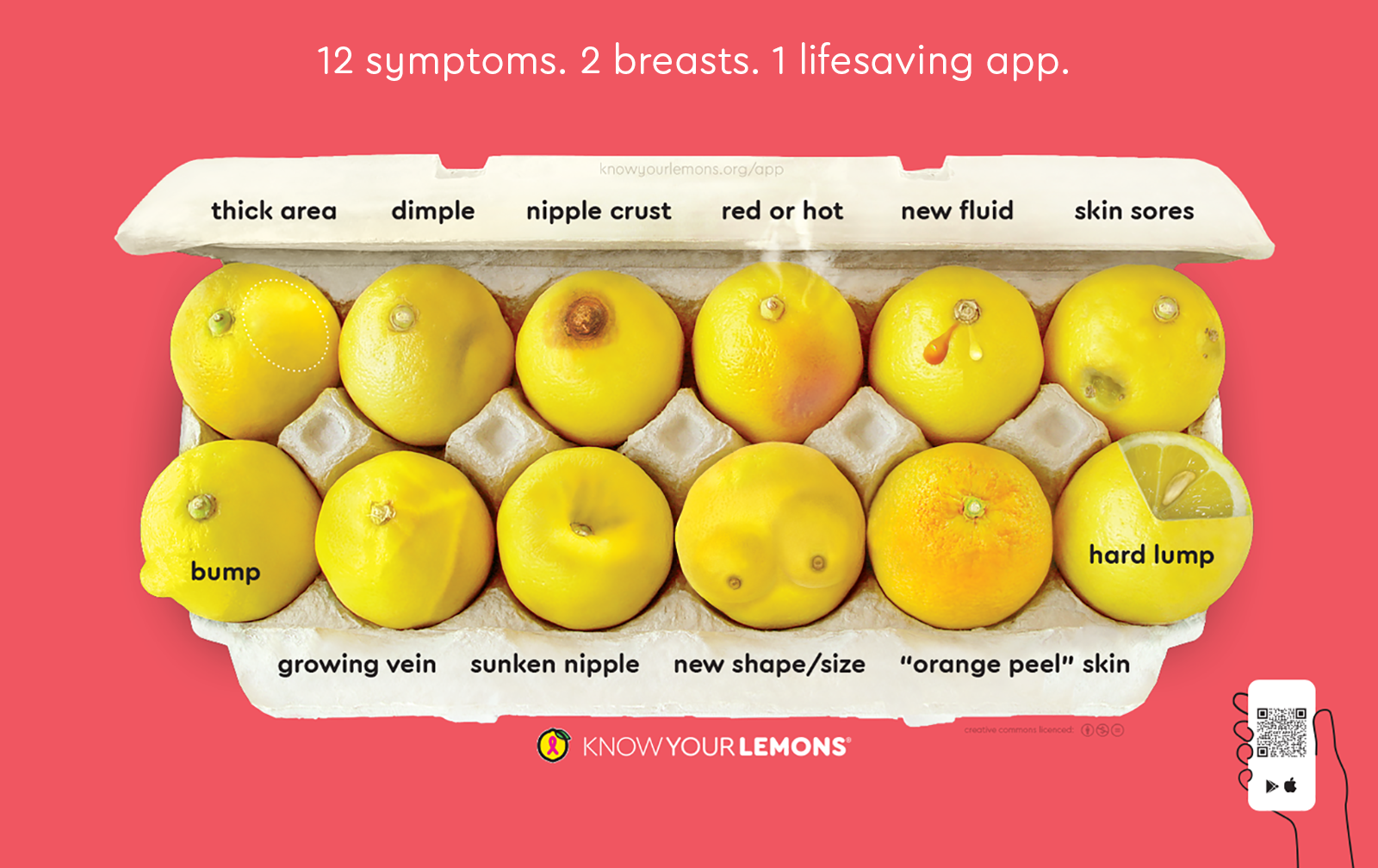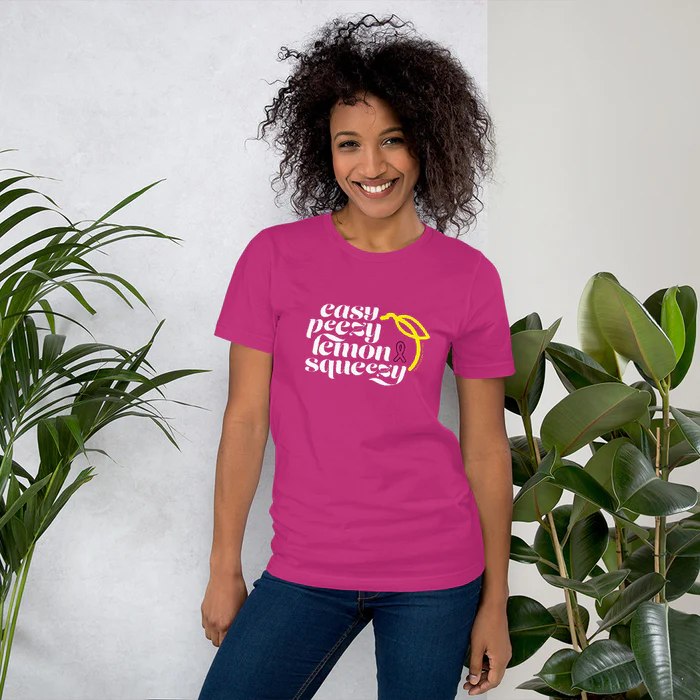12 Symptoms of Breast Cancer:
What it can look and feel like
“Seeing this image of the 12 signs of breast cancer saved my life.” — Emma, UK
For warning signs of breast cancer, there is more than just a lump! Knowing the 12 symptoms of breast cancer can help you be more confident to report a persistent breast change that doesn’t come and go with your menstrual cycle. Our app will guide you and remind you.
A lump is the most common symptom of breast cancer, but it’s not the only symptom.
Learn about each symptom and get the free app to learn about breast cancer risk factors, how to self-exam, schedule a mammogram, and more.
-
The most common sign of breast cancer is a lump, deep in the breast. It often feels hard, like a lemon seed, and usually immovable. It can be any shape or size.
A lump is not always easy to feel. If you have access to breast cancer screening, use it—a mammogram can detect a lump long before it can be felt.
Most lumps turn out to be harmless, such as a fluid filled cyst or a fibroadenoma. But if you notice a hard lump (or any change) that doesn’t come and go with your menstrual cycle, don’t ignore it. The sooner breast cancer is found, the more easily it can be treated.
-
You may notice that a part of your breast feels different from the rest, being less "squishy" and more "dense." This can be a normal part of menstruation or breastfeeding. However, a thickening in your breast that doesn’t go away or gets worse could also be a sign of breast cancer.
The thickening can be in the skin (which is a sign of Inflammatory Breast Cancer) or deeper in the breast. This thickening is caused when cancer cells are blocking circulation in the breast (via blood or lymph vessels) or a tumor is growing near the surface of the skin. This is different from a hard lump, which is formed when cancer cells grow very close together.
Note: This is not to be confused with "breast density" which doesn't refer to how a breast feels. Breast density can only be determined through a mammography report.
-
A dimple (or indentation) in the breast can happen when tight clothing leaves a temporary mark in the skin. But if a dimple in the breast doesn’t go away, it can also be a sign of breast cancer.
This symptom is caused when a tumor (lump) deep in the breast pulls the skin inward causing it to indent (it is not caused by an underwire bra!). Sometimes this lump can be felt, sometimes it can’t.
A dimple can be more easily seen when lifting your arms up above your head to see if the whole breast skin moves with you as you raise and lower your arms. (Pro tip: Having a light source directly overhead can also help cast shadows to show indents more clearly too.)
-
Crust on the nipple can be a harmless skin condition, like eczema, or is a common problem with breastfeeding. But if skin remedies don't fix the problem, it could be a sign of breast cancer called “Paget’s disease.” This is when cancer cells spread inside the breast and live in the nipple, creating a scab-like red or white crusted surface that can be sore and doesn’t go away.
-
Typically, this is an infection or a skin symptom common to developing breasts, breastfeeding or eczema. If time, antibiotics or other treatments don’t improve the symptom, it could be a sign of Inflammatory Breast Cancer. This type of cancer blocks the flow of lymph in the breast, which causes swelling and redness but without an obvious hard lump. This may also make the breast feel warm or hot, or cause a burning sensation. The skin of the breast may also appear pink, reddish purple, or bruised.
This symptom may be difficult to see on a mammogram. Because inflammatory breast cancer is so aggressive, it can progress quickly. Don't hesitate to report a change.
If antibiotics don't clear up the symptoms, then it’s best to see a breast specialist.
Note: This is not the same as breast tenderness, which comes and goes with the menstrual cycle.
-
Discharge from the nipple is common and is harmless (benign) most of the time. It is usually related to developing breasts, infection, cysts, pregnancy, or breastfeeding. However, if fluid is leaking from the breast outside of these changes, it is something that should be checked out, especially if it is clear or contains blood.
-
Breast cancer can sometimes build up to the point that it breaks down the skin of the breast to form an open wound. Infection may cause a bad smell and/or leakage. This is usually accompanied by an obvious hard lump. This is an advanced sign of the disease, meaning it has been present for some time.
-
Sometimes a cancerous lump is on the surface of the breast. However, not all lumps and bumps are cancer. Many are cysts (fluid collections) or harmless, benign lumps made of various tissue (fibroadenomas). Many women have lumpy, bumpy breasts. However, if it’s something that concerns you, show a doctor.
This is not to be confused with an injury to the breast. A direct hit to the breast cannot cause cancer. Sometimes an injury can lead to a lump known as “fat necrosis.” This is scar tissue that can form when the body naturally repairs the damaged fatty breast tissue.
If other tests are inconclusive, such as a mammogram or an ultrasound, looking at the cells from the lump under a microscope (done with a biopsy) can help to determine if it’s cancer.
-
"Enlarged veins" is one of the rarer symptoms of breast cancer and is normally included in general "other unusual changes" or "skin changes" categories. Newly appearing blood vessels or veins are usually not a sign of cancer. More often it is connected to weight gain, breastfeeding, or Mondor's disease. However, if veins become more pronounced outside of these changes, on the breast or near the collarbone (and sometimes accompanied with a swollen arm), this could be a sign of a breast cancer tumor drawing more blood to itself and the vein swelling in size to allow for additional blood flow.
-
Retracted nipples can be a normal shape of the breast (from when the breast was first developed). However, if you notice your nipple sinking, flattening, or turning, it could be a sign of a new breast cancer tumor forming underneath, pulling the nipple toward it as it grows.
-
It’s common for one breast to be different in size and shape from the other. This kind of variety is what our bodies are known for. Breastfeeding can also cause changes in size or shape as a result of milk production. But if one breast changes size, flattens, swells, or droops unexpectedly—and doesn't seem to be connected to your menstruation cycle—this could be a sign of breast cancer.
-
When the skin of the breast looks like the dimpled skin of an orange, this is a symptom of breast cancer known as “peau d’orange,” (how the French say "orange peel"). With peau d’orange, the breast swells to the point it causes hair follicles to look like lots of little dimples.
The skin may or may not change color.
Peau d'orange is a sign of Inflammatory Breast Cancer. This type of cancer blocks the flow of lymph in the breast, which causes swelling and redness but without an obvious hard lump.
Learn about Breast Anatomy for a better self-exam
What does my breast anatomy look like? Understand the difference between normal lumps and suspicious ones by knowing what you are feeling underneath the surface.
Why are mammograms important?
A mammogram can find a cancerous lump before it can be felt. Our app explains when to start, based on your risk and age. Find breast cancer earlier with a mammogram.
How is breast cancer found?
When you are investigating a symptom, it helps to know your testing options and the usual steps to take. Our Know Your Lemons app helps you understand how to prepare for each test (doctor visit, mammogram, ultrasound, breast MRI, and biopsy) and when to go. Our goal? Help you investigate symptoms, get screened, and improve early detection for breast cancer. Explore the 6 ways to detect breast cancer early, from start to finish.







